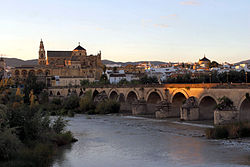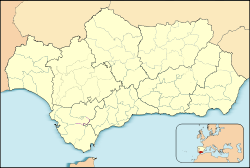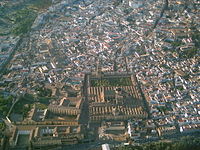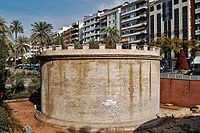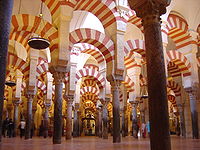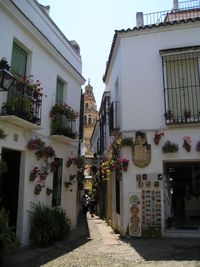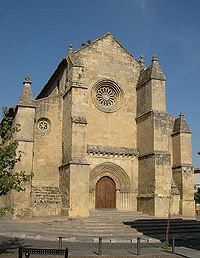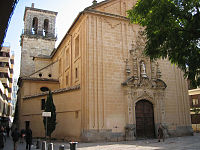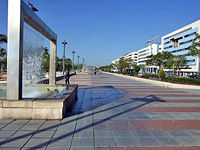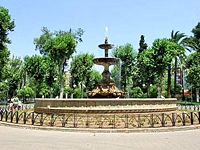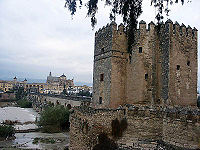- Córdoba, Andalusia
-
For other uses, see Córdoba.
Córdoba — Municipality — View of the Roman bridge and the city of Córdoba 
Flag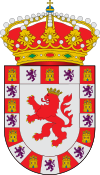
Coat of armsLocation in Andalusia Location in Spain Coordinates: 37°53′0″N 4°46′0″W / 37.883333°N 4.766667°WCoordinates: 37°53′0″N 4°46′0″W / 37.883333°N 4.766667°W Country  Spain
SpainAutonomous community  Andalusia
AndalusiaProvince Córdoba Judicial district Córdoba Founded 169 BC (Roman colony) Government – Type Mayor-council government – Body Ayuntamiento de Córdoba – Mayor José Antonio Nieto Ballesteros (PP) Area – Total 1,255.24 km2 (484.7 sq mi) Elevation 120 m (394 ft) Population (2008) – Total 325,453 – Density 259.3/km2 (671.5/sq mi) Demonym Cordobés/sa, cordobense, cortubí, patriciense Time zone CET (UTC+1) – Summer (DST) CEST (UTC+2) Postal code 14001–14014 Official language(s) Spanish Website Official website Córdoba (Spanish pronunciation: [ˈkorðoβa]; also Cordova) is a city in Andalusia, southern Spain, and the capital of the province of Córdoba. An Iberian and Roman city in ancient times, in the Middle Ages it became the capital of an Islamic caliphate.
The old town contains numerous architectural reminders of when Corduba was the capital of Hispania Ulterior during the Roman Republic and capital of Hispania Baetica during the Roman Empire; and when Qurṭuba (قرطبة) was the capital of the Islamic Caliphate of Córdoba, including most of the Iberian peninsula.
It has been estimated that in the 10th century and beginning of the 11th century, Córdoba was the most populous city in the world,[1][2] and during these centuries became the intellectual center of Europe.[3] Today it is a moderately-sized modern city; its population in 2008 was 325,453.[4]
Historic Centre of Córdoba * UNESCO World Heritage SiteCountry Spain Type Cultural Criteria i, ii, iii, iv Reference 313 Region ** Europe and North America Inscription history Inscription 1984 (8th Session) Extensions 1994 * Name as inscribed on World Heritage List
** Region as classified by UNESCOContents
History
The first trace of human presence in the area are remains of a Neanderthal Man, dating to c. 32,000 BC.[citation needed] In the 8th century BC, during the ancient Tartessos period, a pre-urban settlement existed. The population gradually learned copper and silver metallurgy. The first historical mention of a settlement dates, however, to the Carthaginian expansion across the Guadalquivir, when the general Hamilcar Barca renamed it Kartuba, from Kart-Juba, meaning "the City of Juba", the latter being a Numidian commander who had died in a battle nearby. Córdoba was conquered by the Romans in 206 BC. In 169 the Roman consul Marcus Claudius Marcellus founded a Latin colony alongside the pre-existing Iberian settlement. Between 143 and 141 BC the town was besieged by Viriatus. A Roman Forum is known to have existed in the city in 113 BC.
At the time of Julius Caesar, Córdoba was the capital of the Roman province of Hispania Ulterior Baetica. Great Roman philosophers such as Lucius Annaeus Seneca the Younger, orators such as Seneca the Elder and poets such as Lucan came from Roman Cordoba. Later, it occupied an important place in the Provincia Hispaniae of the Byzantine Empire (552–572) and under the Visigoths, who conquered it in the late 6th century.
Córdoba was captured in 711[5] by an Arab/Berber Muslim army. In 716 it became a provincial capital, subordinate to the Caliphate of Damascus; in Arabic it was known as قرطبة (Qurṭubah). In May 766, it was chosen as the capital of the independent Arab Muslim emirate of al-Andalus, later a Caliphate itself. During the caliphate apogee (1000 AD), Córdoba had a population of roughly 500,000 inhabitants,[6] though estimates range between 350,000 and 1,000,000. In the 10th and 11th centuries, Córdoba was one of the most advanced cities in the world as well as a great cultural, political, financial and economic centre.[citation needed] The Great Mosque of Córdoba dates back to this time; under caliph Al-Hakam II Córdoba had 3,000 mosques, splendid palaces and 300 public baths, and received what was then the largest library in the world, housing from 400,000 to 1,000,000 volumes.
Reinhardt Dozy wrote:,
"The fame of Córdoba penetrated even distant Germany: the Saxon nun Hroswitha, famous in the last half of the 10th century for its Latin poems and dramas, called it the Jewel of the World."[7]After the fall of the caliphate (1031), Córdoba became the capital of a Republican independent taifa. This short-lived state was conquered by Al-Mu'tamid ibn Abbad, lord of Seville, in 1070. In turn, the latter was overthrown by the Almoravids, who were later replaced by the Almohads.
During the latter's domination the city declined, the role of the capital of Muslim al-Andalus having been given to Seville. On 29 June 1236, after a siege of several months, it was captured by King Ferdinand III of Castile, during the Spanish Reconquista. The city was divided into 14 colaciones, and numerous new church buildings were added.
The city declined especially after Renaissance times. In the 18th century it was reduced to just 20,000 inhabitants. The population and economy started to increase only in the early 20th century.
With the most extensive historical heritages in the world declared World Heritage Site by UNESCO (on 17 December 1984), the city also features a number of modern areas, including the districts of Zoco and the railway station district.
The regional government (the Junta de Andalucía) has for some time been studying the creation of a Córdoba Metropolitan Area that would comprise, in addition to the capital itself, the towns of Villafranca de Córdoba, Obejo, La Carlota, Villaharta, Villaviciosa, Almodóvar del Río and Guadalcázar. The combined population of such an area would be around 351,000.
Geography
The city is located on the banks of the Guadalquivir river, and its easy access to the mining resources of the Sierra Morena (coal, lead, zinc) satisfies the population’s needs.
The city is located in a depression of the valley of the Guadalquivir. In the north is the Sierra Morena, which defines the borders of the municipal area.
Córdoba is one of the few cities in the world that has a near-exact antipodal city – Hamilton, New Zealand.
Climate
Córdoba has the highest summer average daily temperatures in Europe (averaging 36.2 °C (97 °F) in July) and days with temperature over 40 °C (104 °F) are common in the summer months. July's 24 hour average of 27.2 °C (81 °F) is also among the highest in Europe, despite having relatively cool nightly temperatures.
Córdoba has a Mediterranean climate with Atlantic coastal influences. Winters are mild with isolated frosts. Precipitation is concentrated in the coldest months; this is due to the Atlantic coastal influence. Precipitation is generated by storms from the west that occur most frequently from December through February. This Atlantic characteristic then gives way to a hot summer with significant drought more typical of Mediterranean climates.
Annual rain surpasses 500 mm, although there is a recognized inter-annual irregularity. In agreement with the Köppen climate classification, the local climate can be described as Csa.
Registered maximum temperatures at the Córdoba Airport (located at 6 km of the city) are 46.6° (23 July 1995) and 46.2° (1 August 2003). The minimum temperature is −8.2° (28 January 2005).[8]
Climate data for Córdoba Month Jan Feb Mar Apr May Jun Jul Aug Sep Oct Nov Dec Year Average high °C (°F) 14.7
(58.5)16.9
(62.4)20.5
(68.9)22.1
(71.8)26.2
(79.2)31.6
(88.9)36.2
(97.2)35.9
(96.6)31.7
(89.1)25.0
(77.0)18.9
(66.0)15.3
(59.5)24.6 Daily mean °C (°F) 9.2
(48.6)10.9
(51.6)13.5
(56.3)15.4
(59.7)19.0
(66.2)23.5
(74.3)27.2
(81.0)27.2
(81.0)24.0
(75.2)18.5
(65.3)13.2
(55.8)10.2
(50.4)17.6 Average low °C (°F) 3.7
(38.7)4.9
(40.8)6.4
(43.5)8.6
(47.5)11.8
(53.2)15.5
(59.9)18.1
(64.6)18.5
(65.3)16.2
(61.2)12.1
(53.8)7.6
(45.7)5.2
(41.4)10.7 Precipitation mm (inches) 64
(2.52)53
(2.09)40
(1.57)61
(2.4)34
(1.34)17
(0.67)3
(0.12)3
(0.12)24
(0.94)62
(2.44)85
(3.35)89
(3.5)536
(21.1)Avg. precipitation days 7 6 5 8 5 2 1 1 2 6 6 8 56 Sunshine hours 168 172 212 212 271 312 352 328 241 208 176 148 2,800 Source: Agencia Estatal de Meteorología[9] Main sights
Historic architecture
Córdoba has the second largest Old town in Europe, the largest urban area in the world declared World Heritage by UNESCO. The most important building and symbol of the city, the Great Mosque of Córdoba and current cathedral, alongside the Roman bridge, are the best known facet of the city. Other Roman remains include the Roman Temple, the Theatre, Mausoleum, the Colonial Forum, the Forum Adiectum, an amphitheater and the remains of the Palace of the Emperor Maximian in the Archaeological site of Cercadilla, among others.
Near the mosque-cathedral is the old Jewish quarter, which consists of many irregular streets, such as Calleja de las Flores and Calleja del Pañuelo, and which is home to the Synagogue and the Sephardic House. In the extreme southwest of the Old Town is the Alcázar de los Reyes Cristianos, a former royal property and the seat of the Inquisition; adjacent to it are the Royal Stables, a breeding place of the Andalusian horse. Near the stables are located, along the walls, the medieval Baths of the Caliphate. In the south of the Old town and east of the great mosque, in the Plaza del Potro, is the Posada del Potro, a row of inns mentioned in literary works such as Don Quixote and La Feria de los Discretos and which remained active until 1972. Both the plaza and the inn get their name from the fountain in the center of the plaza, which represents a foal. Not far from this plaza is the Arco del Portillo (a 14th century arch).
Along the banks of the Guadalquivir are the Mills of the Guadalquivir, Muslim era buildings that took advantage of the water force to grind the flour. They include the Albolafia, Alegría, Carbonell, Casillas, Enmedio, Lope García, Martos, Pápalo, San Antonio, San Lorenzo and San Rafael mills.
Surrounding the large Old town are the Roman walls: gates include the Puerta de Almodóvar, the Puerta de Sevilla and Puerta del Puente, which are the only three gates remaining from the original thirteen. Towers and fortresses include the Malmuerta Tower, the Belén Tower and the Puerta del Rincón's Tower, and the fortress of the Calahorra Tower and of the Donceles Tower.
Palace buildings in the Old Town include the Palacio de Viana (14th century) and the Palacio de la Merced among others. On the outskirts of the city lies the Archaeological site of the city of Medina Azahara, which, together with the Alhambra in Granada, is one of the main Spanish-Muslim architectures in Spain.
Other sights are the Cuesta del Bailío (a staircase connecting the upper and lower part of the city) and the Minaret of San Juan, once part of an Islamic mosque.
Fernandine churches
The city is home to 12 Christians churches that were to built (many as transformations of mosques) by Ferdinand III of Castile after the reconquest of the city in the 13th century. They should both acts as churches and as the administrative centers in the neighborhoods in which it the city was divided in medieval times. Some of those that remain are:
- San Nicolás de la Villa.
- San Miguel.
- Church of San Juan y todos los Santos, on the Lope de Hoces Street.
- Santa Marina de Aguas Santas.
- San Agustín. Begun in 1328, it has now a 18th century appearance. The façade bell tower, with four bells, dates to the 16th century.
- San Andrés, largely renovated in the 14th and 15th centuries. It has a Renaissance portal (1489) and a bell tower from the same age, while the high altar is a Baroque work by Pedro Duque Cornejo.
- San Lorenzo.
- Church of Santiago.
- San Pedro.
- Church of La Magdalena. Like the others, it combines Romanesque, Mudéjar and Gothic elements.
- San Pablo. In the church's garden in the 1990s the ruins of an ancient Roman circus were discovered.[10]
Other religious structures
- San Hipólito. It houses the tombs of Ferdinand IV and Alfonso XI of Castile, kings of Castile and León.
- San Francisco
- San Salvador y Santo Domingo de Silos
- Shrine of Nuestra Señora de Linares
- Tower of Santo Domingo de Silos
- Shrine of Nuestra Señora de la Fuensanta
- Chapel of San Bartolomé
Sculptures and memorials
Scattered throughout the city are ten statues of Archangel Raphael, protector and custodian of the city. These are called Triumphs of Saint Raphael and are located in landmarks such as the Roman Bridge, the Puerta del Puente and the Plaza del Potro.
In the western part of the Historic Centre are the statue to Seneca (near the Puerta de Almodóvar, a gate of Islamic ordigina), the Statue of Averroes (next to the Puerta de la Luna), and Maimonides (in the plaza de Tiberiades). Further south, near the Puerta de Sevilla, are the sculpture to the poet Ibn Zaydún and the sculpture of the writer and poet Ibn Hazm and, inside the Alcázar de los Reyes Cristianos, the monument to the Catholic Monarchs and Christopher Columbus.
There are also several sculptures placed in plazas of the Old Town. In the central Plaza de las Tendillas is the equestrian statue of the Gonzalo Fernández de Córdoba, in the Plaza de Capuchinos is the Cristo de los Faroles, in Plaza de la Trinidad is the statue of Luis de Góngora, in the Plaza del Cardenal Salazar is the bust of Ahmad ibn Muhammad abu Yafar al-Gafiqi, in the Plaza de Capuchinas is the statue to the bishop Osio, in Plaza del Conde de Priego is the monument to Manolete and the Campo Santo de los Mártires is a statue to Al-Hakam II and the monument to the lovers.
In the Jardines de la Agricultura is the monument to the painter Julio Romero de Torres, a bust by sculptor Mateo Inurria, the bust of the poet Julio Aumente and the sculpture dedicated to the gardener Aniceto García Roldán, who was killed in the park. Further south, in the Gardens of the Duke of Rivas, is a statue of the writer and poet Ángel de Saavedra, 3rd Duke of Rivas made by the sculptor Mariano Benlliure.
In the Guadalquivir river, near the San Rafael Bridge is the Island of the sculptures, an artificial island with a dozen stone sculptures executed during the International Sculpture Symposium. Up the river, near the Miraflores bridge, is the "Hombre Río", a sculpture of a swimmer looking to the sky and whose orientation varies depending from the current.
Gardens, parks and natural environments
 Gardens of the Alcázar de los Reyes Cristianos.
Gardens of the Alcázar de los Reyes Cristianos.
- Jardines de la Victoria. Within the gardens there are two newly renovated facilities, the old Caseta del Círculo de la Amistad, today Caseta Victoria, and the Kiosko de la música, as well as a small Modernist fountain from the early 20th century. The northern sector, called Jardines of Duque de Rivas, features a pergola of neoclassical style, designed by the architect Carlos Sáenz de Santamaría; it is used as an exhibition hall and a café bar.
- Jardines de la Agricultura, located between the Jardines de la Victoria and the Paseo de Córdoba: it includes numerous trails that radially converge to a round square which has a fountain or pond. This is known as the duck pond, and, in the center, has an island with a small building in which these animals live. Scattered throughout the garden are numerous sculptures such as the sculpture in memory of Julio Romero de Torres, the sculpture to the composer Julio Aumente and the bust of Mateo Inurria. In the north is a rose garden in form of a labirynth.
- Parque de Miraflores, located on the south bank of the river Guadalquivir. It was designed by the architect Juan Cuenca Montilla as a series of terraces. Among other points of interest as the Salam and Miraflores Bridge and a sculpture by Agustín Ibarrola.
- Parque Cruz Conde, located southwest of the city, is an open park and barrier-free park in English gardens style.[11]
- Paseo de Cordoba. Located on the underground train tracks, it is a long tour of several kilometers in length with more than 434,000 m². The tour has numerous fountains, including six formed by a portico of falling water which form a waterfall to a pond with four levels. Integrated into the tour is a pond of water from the Roman era, and the building of the old train station of RENFE, now converted into offices of Canal Sur.
- Jardines Juan Carlos I, in the Ciudad Jardín neighborhood. It is a fortress which occupies an area of about 12,500 square meters.
- Jardines del Conde de Vallellano, located on both sides of the avenue of the same name. It includes a large L-shaped pond with a capacity of 3,000 m3 (105,944.00 cu ft) and archaeological remains embedded in the gardens, among which is a Roman cistern from the second half of the 1st century BC.
- Parque de la Asomadilla, with a surface of 27 hectares, is the second largest park in Andalusia.[12] The park recreates a Mediterranean forest vegetation, such as hawthorn, pomegranate, hackberry, oak, olive, tamarisk, cypress, elms, pines, oaks and carob trees among others.
- Balcón del Guadalquivir
- Jardines de Colón'
- Sotos de la Albolafia. Declared Natural monument by the Andalusian Autonomous Government, it is located in a stretch of the Guadalquivir river from the Roman Bridge and the San Rafael Bridge, with an area of 21.36 hectares.[13] Host a large variety of birds and is an important point of migration for many birds.
- Parque periurbano Los Villares
Bridges
Córdoba has a total of seven bridges, one of which is under construction.
- Roman Bridge, over the Guadalquivir River. It links the area of Campo de la Verdad with Barrio de la Catedral. It was the only bridge of the city for twenty centuries, until the construction of the San Rafael Bridge in the mid-20th century. Built in the early 1st century BC, during the period of Roman rule in Córdoba, probably replacing a more primitive of wood, it has a length of about 250 meters and consists of 16 arches.
- San Rafael Bridge, consisting of eight arches of 25 m span and a length of 217 meters. The width is between parapets, divided into 12 meters of cobblestone for four circulations and two tiled concrete sidewalks. It was inaugurated on 29 April 1953 joining the Avenue Corregidor with Plaza de Andalucía. In January 2004, the plaques reading "His Excellency the Head of State and Generalissimo of all the Armies, Francisco Franco Bahamonde, opened this bridge of the Guadalquivir on 29 April 1953", which were in each of the entrances of the bridge, each in its own direction, were removed.
- Andalusia Bridge, a suspension bridge.
- Puente de Miraflores, known as "the rusty bridge". This bridge links the Street San Fernando and Ronda de Isasa with the Miraflores peninsula. It was designed by Herrero, Suárez and Casado and inaugurated on 2 May 2003. At first, in 1989, had considered the proposal[14] of the architect-engineer Santiago Calatrava, that would looks like the Lusitania Bridge of Mérida, but was eventually discarded because of is potential impact on the artistic whole of the historic, because with its height could cover the view of the Great Mosque.
- Autovía del Sur Bridge.
- Abbas Ibn Firmas Bridge, under construction. It is part of the future variant west of Córdoba.
- Puente del Arenal, connecting Avenue Campo de la Verdad with the Recinto Ferial (fairground) of Cordoba.
Politics and government
- Local administration
Currently the mayor of Córdoba is Andrés Ocaña, United Left, since the 8 May 2009 after replacing Rosa Aguilar because she left the party.[15]
The City Council of Córdoba is divided into different areas: the Presidency, Security, Mobility, Equality and Participation; the Planning, Housing, Infrastructure and Environment; the Economy, Trade, Employment and Management; the Social; the Cultural Services and Tourism.[16] The council holds regular plenary session once a month, but often held extraordinary plenary session to discuss issues and problems affecting the city.[17]
The Governing Board, chaired by the mayor, consists of five councillors of United Left (IU), two councilors of Spanish Socialist Workers' Party (PSOE) and other three members not elected.[18][19] The municipal council consists of 29 members: 14 of People's Party, 11 of IU and 4 of PSOE.
List of mayors since the democratic elections of 1979 Legislature Name Party 1979–1983 Julio Anguita PCE 1983–1987 Julio Anguita (until February 1, 1986)
Herminio TrigoPCE(IU) 1987–1991 Herminio Trigo IU 1991–1995 Herminio Trigo IU Manuel Pérez Pérez IU 1995–1999 Rafael Merino PP 1999–2003 Rosa Aguilar IU 2003–2007 Rosa Aguilar IU 2007–2011 Rosa Aguilar (until April 23, 2009)
Andrés OcañaIU - Administrative division
Since July 2008, the city is divided into 10 administrative districts, coordinated by the Municipal district boards, which in turn are subdivided into neighbourhoods
District District Location Centro Poniente-Sur 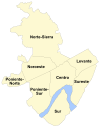
Levante Sur Noroeste Sureste Norte-Sierra Periurbano Este-Campiña Poniente-Norte Periurbano Oeste-Sierra Museums
- Archeological and Ethnological Museum of Córdoba.
- Julio Romero de Torres Museum.
- Museum of Fine Arts.
- Dioceses Museum.
- Baths of the Fortress Califal.
- Botanical Museum of Cordova.
- Three Cultures Museum.
- Bullfighting Museum.
- Molino de Martos Hydraulic Museum.
Theatres
- Gran Teatro de Córdoba.
- Teatro Axerquía.
- Teatro Góngora.
May celebrations
Tourism is especially intense in Córdoba during May because of the weather and as this month hosts three festivals.[20]
The May Crosses Festival takes place at the beginning of the month. During three or four days, crosses of around 3 meters of height are placed in many squares and streets and decorated with flowers and a contest is held to choose the most beautiful one. Usually there is regional food and music near the crosses.
The Patios Festival is celebrated during the second and third week of the month. Many houses of the historic center open their private patios to the public and compete in a contest. Both the architectonic value and the floral decorations are taken into consideration to choose the winners. It is usually very difficult and expensive to find accommodation in the city during the festival.
Córdoba's Fair takes place at the ending of the month and is similar to the better known Seville Fair with some differences, mainly that the Seville one is private, while the Cordoba one is not.
People
Córdoba was the birthplace of the following philosophers and religious scholars:
- In Roman times the Stoic philosopher Seneca,
- In Islamic times
- The Islamic scholar ibn Hazm, a major Muslim theologian and legal jurist,
- The Islamic scholar ibn Rushd or Averroes, one of Islam's most famous and eminent scholars and philosophers,
- Imam Abu 'Abdullah al-Qurtubi, a leading jurist of the Maliki madhab, and
- The rabbi and Jewish philosopher Moses Maimonides.
Córdoba was also the birthplace of
- The Roman poet Lucan,
- The medieval Spanish poet Juan de Mena
- The Renaissance poet Luis de Góngora, who lived most of his life and wrote all his most important works but one in Córdoba.
The Renaissance philosopher Abraham Cohen de Herrera and the Jewish mystic Moses ben Jacob Cordovero both descended from families which lived in Córdoba before the expulsion of the Jews from Spain.
The painter Julio Romero de Torres (1874–1930).
More recently, several flamenco artists were born here as well, including
Also recently
- Fernando Tejero, actor
Transport
The city is connected by high speed trains to the following Spanish cities: Madrid, Barcelona, Seville, Málaga and Zaragoza. More than 20 trains per day connect the downtown area, in 54 minutes, with Málaga María Zambrano station, which provides interchange capability to destinations along the Costa del Sol, including Málaga Airport.
Twin towns – sister cities
 Córdoba, Argentina, since 1969
Córdoba, Argentina, since 1969 A Coruña, Spain, since 1976
A Coruña, Spain, since 1976 Córdoba, Mexico, since 1980
Córdoba, Mexico, since 1980 Fes, Morocco, since 1982
Fes, Morocco, since 1982 Smara, Western Sahara, since 1987
Smara, Western Sahara, since 1987 La Habana Vieja, Cuba, since 2000
La Habana Vieja, Cuba, since 2000 Damascus, Syria, since 2001
Damascus, Syria, since 2001 Nuremberg, Germany, since 2010
Nuremberg, Germany, since 2010 León, Spain, since 2010
León, Spain, since 2010 Lahore, Pakistan
Lahore, Pakistan Bukhara, Uzbekistan
Bukhara, Uzbekistan Manchester, UK
Manchester, UK Bethlehem, Palestine Territory
Bethlehem, Palestine Territory Adana, Turkey
Adana, Turkey Derna, Libya
Derna, Libya
References
- ^ "10th Century Timeline: 901 to 1000". Fsmitha.com. http://www.fsmitha.com/time/ce10.htm. Retrieved 7 January 2011.
- ^ http://geography.about.com/library/weekly/aa011201a.htm
- ^ "Spain: 500 to 1200 CE". Fsmitha.com. http://www.fsmitha.com/h3/h08hispania.htm. Retrieved 7 January 2011.
- ^ "Instituto Nacional de Estadística. (Spanish Statistical Institute)". Ine.es. http://www.ine.es/nomen2/index.do?accion=busquedaRapida&subaccion=&numPag=0&ordenAnios=ASC&nombrePoblacion=cordoba&botonBusquedaRapida=Consult+selection. Retrieved 7 January 2011.
- ^ "Córdoba History". http://www.cordoba24.info/english/html/geschichte.html. Retrieved 16 July 2009.
- ^ J. Bradford De Long and Andrei Shleifer (October 1993), "Princes and Merchants: European City Growth before the Industrial Revolution", The Journal of Law and Economics (University of Chicago Press) 36 (2): 671–702 [678]
- ^ "Spain from the 6th to 12th Century History". http://www.fsmitha.com/h3/h08hispania.htm.
- ^ "Valores climatológicos extremos. Córdoba" (in (Spanish)). Aemet.es. http://www.aemet.es/es/elclima/datosclimatologicos/efemerides_extremos?o=5402&v=Tmn&m=13. Retrieved 7 January 2011.
- ^ "Valores Climatológicos Normales. Córdoba / Aeropuerto". http://www.aemet.es/es/elclima/datosclimatologicos/valoresclimatologicos?l=5402&k=and.
- ^ "Discovery of a Roman Circus in Cordoba". Artencordoba.co.uk. http://www.artencordoba.co.uk/ROMAN-CORDOBA/Roman-Cordoba-Circus.html. Retrieved 7 January 2011.
- ^ Parque Cruz Conde[dead link]
- ^ El parque de La Asomadilla se inicia con la apertura de pozos, Diario Córdoba website.
- ^ Los Sotos de la Albolafia, Inventario de Humedales de Andalucía.
- ^ "Projects of Santiago Calatrava". Soloarquitectura.com. http://www.soloarquitectura.com/arquitectos/santiago_calatrava.html. Retrieved 7 January 2011.
- ^ Andrés Ocaña is the Mayor of Cordoba "with the unanimous support of all IU (in spanish).
- ^ Municipal Organizational of the areas of the City Council of Cordoba[dead link]
- ^ Organic Regulations of the plenary of the City Council of Córdoba[dead link]
- ^ Local governing board ofthe City Council of Córdoba[dead link], official website of the City Council of Córdoba
- ^ Municipal Elections 2007 in Córdoba: Cargos en la Corporación Municipal – Article of Cordobapedia published in Castilian, GFDL license.
- ^ "Mayocordobes.es". Mayocordobes.es. 15 November 2007. http://www.mayocordobes.es. Retrieved 7 January 2011.
- ^ "Hermanamientos". Ayuncordoba.es. http://www.ayuncordoba.es/hermanamientos.html. Retrieved 7 January 2011.
External links
- Official website of the city council. (Spanish)
- Tourism of Cordoba (English)
- Tourism and Monuments in Córdoba (English)
- Córdoba travel information (English)
- (Spanish) Natural Monument Sotos de la Albolafia
- Córdoba: The City that Changed the World by The Guardian
- Córdoba Mosque and Roman Bridge – The second largest mosque and a Roman Bridge with 17 arches Córdoba, Roman City (Spain)
- Spainish Tourism Board official website in English for United States
World Heritage Sites in Spain For official site names, see each article or the List of World Heritage Sites in Spain.North West Caves of Altamira and Paleolithic Cave Art of Northern Spain1 · Monuments of Oviedo and the Kingdom of the Asturias · Roman Walls of Lugo · Route of Santiago de Compostela1 · Santiago de Compostela · Tower of Hercules
North East Caves of Altamira and Paleolithic Cave Art of Northern Spain1 · Mudéjar Architecture of Aragon · Pyrénées - Mont Perdu2 · Rock-Art of the Mediterranean Basin on the Iberian Peninsula1 · Route of Santiago de Compostela1 · San Millán Yuso and Suso Monasteries · Vizcaya Bridge
Community of Madrid Aranjuez Cultural Landscape · El Escorial · University and Historic Precinct of Alcalá de Henares
Centre Archaeological Ensemble of Mérida · Archaeological Site of Atapuerca · Ávila with its Extra-mural Churches · Burgos Cathedral · Cáceres · Cuenca · Las Médulas · Rock-Art of the Mediterranean Basin on the Iberian Peninsula1 · Route of Santiago de Compostela1 · Salamanca · Santa María de Guadalupe · Segovia and its Aqueduct · Toledo · Prehistoric Rock-Art Sites in the Côa Valley and Siega Verde
East Archaeological Ensemble of Tarraco, Tarragona · Catalan Romanesque Churches of the Vall de Boí · Ibiza (Biodiversity and Culture) · Palau de la Música Catalana and Hospital de Sant Pau, Barcelona · Palmeral of Elche · Poblet Monastery · Rock-Art of the Mediterranean Basin on the Iberian Peninsula1 · Silk Exchange in Valencia · Works of Antoni Gaudí
South Alhambra, Generalife and Albayzín, Granada · Cathedral, Alcázar and Archivo de Indias, Seville · Córdoba · Doñana · Renaissance Monuments of Úbeda and Baeza · Rock-Art of the Mediterranean Basin on the Iberian Peninsula1
Canary Islands 1 Shared with other region/s · 2 Shared with FranceCapitals of provinces 
Port cities Algeciras · Almuñécar · Benalmádena · Chipiona · El Puerto de Santa María · Fuengirola · Marbella · Moguer · Motril · Nerja · San Fernando · Sanlúcar de Barrameda · TorremolinosOther cities Antequera · Aracena · Baeza · Cazorla · Dos Hermanas · Grazalema · Guadix · Jerez de la Frontera · Linares · Ronda · Rota · Santiponce · ÚbedaCapitals of provinces of Spain A Coruña · Albacete · Alicante · Almería · Ávila · Badajoz · Barcelona · Bilbao · Burgos · Cáceres · Cádiz · Castellón de la Plana · Ciudad Real · Córdoba · Cuenca · Donostia-San Sebastián · Girona · Granada · Guadalajara · Huelva · Huesca · Jaén · Logroño · Las Palmas de Gran Canaria · León · Lleida · Lugo · Madrid · Málaga · Murcia · Ourense · Oviedo · Palencia · Palma · Pamplona · Pontevedra · Salamanca · Santander · Santa Cruz · Segovia · Seville · Soria · Tarragona · Teruel · Toledo · Valencia · Valladolid · Vitoria-Gasteiz · Zamora · Zaragoza
Comarcas of Autonomous
Community of AndalusiaLa Accitania · Alhama · El Aljarafe · Alpujarra Almeriense · Alpujarra Granadina · Alto Guadalquivir · El Andévalo · Antequera · La Axarquía · Bay of Cádiz · Bajo Guadalquivir · Baza · Campiña de Baena · Campiña de Carmona · Campiña de Jaén · Campiña de Jerez · Campiña de Morón y Marchena · Campiña Sur Cordobesa · Campo de Gibraltar · Condado de Huelva · Condado de Jaén · Córdoba · Costa del Sol Occidental · Costa Noroeste de Cádiz · Costa Occidental de Huelva · Costa Tropical · Cuenca Minera · Écija · Filabres-Tabernas · Guadalteba · Huéscar · Jaén · La Janda · Levante Almeriense · Loja · La Loma · Málaga-Costa del Sol · Comarca Metropolitana de Almería · Comarca Metropolitana de Huelva · Comarca Metropolitana de Sevilla · Los Montes · Nororma · Poniente Almeriense · Serranía de Ronda · Sierra de Cádiz · Sierra de Cazorla · Sierra de Huelva · Sierra Mágina · Sierra de las Nieves · Sierra Norte de Jaén · Sierra Norte de Sevilla · Sierra de Segura · Sierra Sur de Jaén · Sierra Sur de Sevilla · La Subbética · Valle del Almanzora · Valle del Guadalhorce · Valle del Guadiato · Valle de Lecrín · Valle de los Pedroches · Valle Medio del Guadalquivir · Vega de Granada · Vega del Guadalquivir · Los Vélez ·
Las VillasCategories:- Córdoba, Spain
- Al-Andalus
- Archaeological sites in Spain
- Historic Jewish communities
- Municipalities in Córdoba
- Naturalis Historia Book 3: Europe Part 1
- Naturalis Historia Encyclopedia
- Roman colonies
- Roman sites in Spain
- World Heritage Sites in Spain
- 3rd-century BC establishments
Wikimedia Foundation. 2010.

